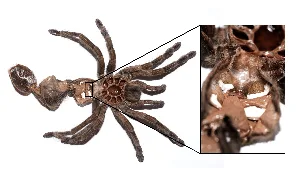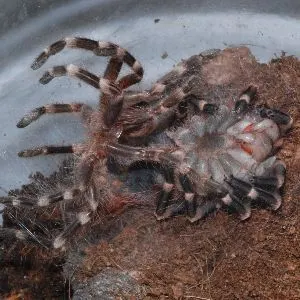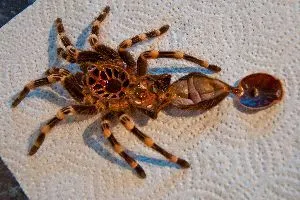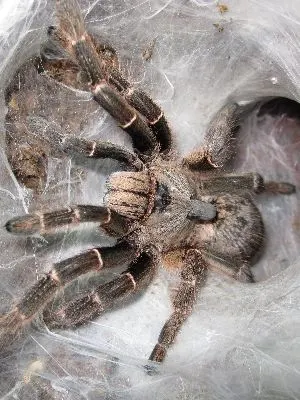Tarantula Molting
Every tarantula will go through a process called “molting” and as their keeper, you will inevitably have to learn about your pet tarantula’s molting process. This is how your spider grows and is a crucial part of their life.
Tarantulas must periodically shed their exoskeleton once they have grown a new one underneath. You will see your tarantula grow dramatically after each molt and it will happen multiple times before they reach maturity.
The process can make you feel uneasy or cause your skin to crawl, but it is a very healthy and important process for your tarantula to go through. It is also a very draining process for them.
Check out this time-lapse video of a tarantula molting to get an idea of what they will be going through physically:
<center>
You must inform yourself on how to support and get through their molting processes in order to provide and react in the ways they need you to during this hard time. A failed molt can be fatal to tarantulas so, as their owner, you should know how to make sure it all goes smoothly.
Things You Should Know About Molting

Molting can seem like a mysterious and scary process but we can assure you that it is part of their nature and that they will eventually get through it alright if their enclosures are the right space for them to go through this process.
Here are some important facts you should know about the tarantula molting process:
Frequency
Depending on what species of spider you have, you may see them molt every six months up to once a year. If your spider is younger, you may even see them molt as often as once a month.
When they start to outgrow their current exoskeleton, their hormones will react by secreting a special fluid that will loosen their exoskeleton, allowing them to evacuate their former shell.
Your spider’s species, age, and the environment of their enclosure will play a huge role in how often they molt. Most spiders will continue to do this throughout their lives, and some males may not become fully grown up until their very last molt in life.
Molting may also become less frequent when they are nearing the end of their lifetime, some not molting for multiple years.
Duration
The molting process can last anywhere as quick as 15 minutes to as long as 15 hours. This will all depend on your spider’s age; the older they are, the longer it will take.
You should not try to mess with them at this time, as they should be able to take all the time they need.
Watch for the molt so you can remove it when it happens, but don’t disturb your spider and allow them to go through the process with as much time as they need.
Signs of Premolt

It is important to know that tarantulas can take up to weeks until they actually start molting. In fact, the preparation for molting can begin months before the actual molt.
You must allow your spider to go through their processes undisturbed.
Appetite
The first thing you might notice from your pre-molting tarantula is a huge loss in appetite. If they are not touching their food and nothing else seems to be wrong, they might be getting ready to molt.
Don’t worry about your spider not eating for long periods of time because they can go quite a while without food. It is normal for them to stop feeding for a few weeks prior to a molt.
Their appetites will change drastically when they are about to molt, so don’t fret.
Activity
While they are preparing for this process, you may see a complete halt in their overall activity, this includes eating and moving around.
They may also become very sluggish and slower-moving than normal.
Bald Spot
A tarantula in pre-molt will usually have a bald spot on their abdomen right where you could see it. This is a good indication that your spider is getting ready to shed some skin, as they’ve already shed a little bit of hair.
This bald spot may grow increasingly darker as their molt day approaches.
Spinning Webs
A pre-molting tarantula will start to make a webbed bed or may create a silk mat for themselves to comfortably molt on. This is a good sign that they are coming close to time to molt and preparing for the process to happen.
Coloration
Paying attention to their coloration is the easiest way to tell they are very close to molting. As soon as they secrete their molting fluid, their exoskeleton will start to peel away, causing it to turn a duller grey or purple-ish grey.
This dull coloration means that they are very close to molting.
Laying Upside Down
The first thing a tarantula will do when they finally do go into a molt is turn their bodies upside down. This is a good sign that they are ready to start molting.
They will go through the molting process completely while on their back. When they are finished molting, they will turn back around and get on their new legs.

Preparation
Once you notice the signs of premolt, there are some things that you can do to support a healthy molt for your pet spider.
The most important thing you can do for your tarantula is provide the proper environment for them to go through these processes. Make sure the temperatures and humidity are ideal for your species of tarantula.
Support a successful molt by keeping their tank clean as they are weaker and more susceptible to illness or injury. Remove any uneaten prey as soon as possible to avoid these issues.
Speaking of eating; don’t forget that their appetite will shift before their molt actually happens so make sure you don’t force them to eat, but rather give them the option. If they are not eating at all, let them do their thing.
Be sure to keep a small water bowl in the enclosure for them as well.
Basically, the best way to support a successful molt is to keep track of its temperatures and humidity levels. Let them do their thing and just make sure to keep an eye on them while the process happens.
Molting Process
When the time has finally come to molt, you best leave your pet spider be.
It can look alarming and you might be worried seeing it look like it’s struggling on its back, but interfering can be fatal. Even if their position seems unnatural, this is how a molt normally looks.
This is a fragile and intense time for them. Keep an eye on them, but also keep your distance.
You will see them lay on their back and struggle, moving their legs around a little bit. At some point, you might even be able to witness them pushing their new body out of their old exoskeleton.
Molting can take anywhere from fifteen minutes to a whole day, so do not be alarmed if yours takes a bit longer or is done way faster than you imagined.
Many owners might worry that their spider is dead or dying, as it may certainly look like it but tarantulas will rarely be caught dead on their back. When they die, they will actually curl up their legs inwards underneath their bodies.
It is important to know the difference just in case something goes wrong in the process. A tarantula getting stuck in their molt hardly ever survives, unfortunately.
After Molt

Once your tarantula is back to normal and you can see the exoskeleton left in their cage, you will notice their new, upgraded looks. They might even have some changes you didn’t see before!
Once their exoskeleton is completely shed off their bodies, you can use a pair of tweezers to remove it from their enclosure to lightly pick it up. Some people will store it to monitor growth or as a keepsake, but you can also just throw it out.
Check out your spider’s new coat or skin, look for any new markings or colorations and make sure to give them some water and that they eventually get back on their normal eating schedule!

FAQ
Is my tarantula molting or dying?
Again, the process can look a little bit worrisome, which might leave owners uneasy. We are here to clear up the differences for you.
During a molt, a tarantula will lie upside down on its back or slightly onto one side (this is normal too) and may flail or twitch its legs in the air. This can go on for a few hours or sometimes way less, depending on your spider.
If your tarantula is dead or dying, it will be on its stomach and will curl its legs inwards tightly. It is much more common for a spider to die on its stomach, but it may accidentally flip onto its back, so just look for the leg curling, since that is the best indicator of death.
Hemolymph pressure when death occurs causes them to extend their legs, which will oppose their flexing muscles. When their heart stops beating and there is no resisting pressure, the action of only the flexor muscles will cause their legs to curl.
Now, when a tarantula finishes molting, it may lay in all kinds of weird positions for a little while, but don’t worry about it, and make sure to provide them with some water.
An important thing to mention is that a tarantula can sustain injuries or even die if something goes wrong with its molt or it is disturbed in any way. The most common issue is when a spider gets stuck in its old carapace, becoming trapped, leading to a slow death.
This is why it is important to know the differences between death and molting and how it all looks so you can keep an eye on them during this hard process.
Can I feed my tarantula during a molt?
As mentioned before, their appetite will almost completely go away before a molt, so don’t worry about feeding them too much. They can go a whole year and more without food so a little while won’t be a big deal at all.
In fact, during a molt, they will not want to eat at all. They will become very lethargic and will not be very active at all.
After they get through their molt, you might want to wait a week or so until you even attempt to offer them anything. You should definitely wait at least five days before you even offer them food.
The reason to wait before giving them food is due to their new exoskeleton. It needs at least five days to harden up enough to protect your spider from its prey.
If it refuses food after a few minutes, you should remove it and then try again in a few days. Take it slow and give them time to relax after their molt.
Is my tarantula molting too slowly?
The answer is no! Some will molt slower than others and some faster than others. It will all depend on your tarantula’s environment, metabolism, age, gender, and overall state.
Don’t rush your pet spider and let them take their time to go through their own natural processes. We can’t rush these things.
So just relax, check their temperatures, provide proper humidity, water, and watch your tarantula go through a beautiful metamorphosis.
Conclusion
Now that you know more about how tarantulas molt, you can fully support your pet tarantula through a healthy molt.
This is a totally natural part of their life cycle and only means they are healthy. Your spider is growing and maturing.
You might want to look out for any new changes in your tarantula after their molt as well; sometimes there are upgrades.
Leave any questions or comments you might have about molting below!
More tarantulas stuff
Table of Contents

Shirley
Monday 31st of July 2023
Can I come out in a rash after handling a molt